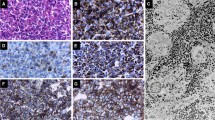Abstract
A pituitary adenoma with neuron-like differentiation in the sella turcica is reported. Sections of the tumor showed a mixture of adenoma cells, ganglionic cells, and neuropil-like structures by light microscopy. Both pituitary adenoma cells and large cells recognized as ganglionic cells by H&E were strongly immunoreactive for both growth hormone (GH) and prolactin (PRL), which indicated that these large cells had properties similar to those of pituitary adenoma cells. Furthermore, electron microscopy (EM) revealed characteristic low electron-dense secretory granules as well as GH-type large electron-dense secretory granules in adenoma cells, neuropils, and swollen bulbs of neuronal endings, which indicated that these three populations may be of the same origin. Furthermore, we could not find typical cell bodies of ganglionic cells by EM. These results are consistent with a hypothesis that attempts to explain the origin of the neuronal components by the neuronal differentiation of adenoma cells. Thus, the best designation of our tumor may be “pituitary adenoma with neuron-like differentiation.”
Similar content being viewed by others
References
Kiyono H. Die Histopathologie der Hypophyse. Virchows Arch A Pathol Anat Histopathol 259:388–465, 1926.
Puchner MJA, Ludecke DK, Saeger W, Riedel M, Asa SL. Gangliocytomas of the sellar region—a review. Exp Clin Endocrinol 103:129–149, 1995.
Fisher EG, Morris JH, Kettyle WM. Instrasellar gangliocytoma and syndromes of pituitary hypersecretion. J Neurosurg 59:1071–1075, 1983.
Jakumeit H-D, Zimmermann V, Guiot G. Intrasellar gangliocytomas: report of four cases. J Neurosurg 40:626–630, 1974.
Asa SL, Sheithauer BW, Bilbao JM, Horvath E, Ryan N, Kovacs K, Randall RV, Laws ER Jr, Singer S, Linfoot JA, Thorner MO, Vale W. A case for hypothalamic acromegaly: a clinicopathological study of six patients with typothalamic gangliocytomas producing growth hormone-releasing factor. J Clin Endocrinol Metab 58:796–803, 1984.
Bevan JS, Asa SL, Rossi ML, Esiri MM, Adams CBT, Burke CW. Intrasellar gangliocytoma containing gastrin and growth hormone-releasing hormone associated with a growth hormone-secreting pituitary adenoma. Clin Endocrinol 30:213–224, 1989.
Li JY, Racadot O, Kujas M, Kouadri M, Peillon F, Racadot J. Immunocytochemistry of four mixed pituitary adenomas and intrasellar gangliocytomas asociated with different clinical syndromes: acromegaly, amenorrhea-galactorrhea, Cushing’s disease, and isolated tumoral syndrome. Acta Neuropathol (Berl) 77:320–328, 1989.
Asada H, Otani M, Furuhata S, Inoue H, Toya S, Ogawa Y. Mixed pituitary adenoma and gangliocytoma associated with acromegaly. Neurol Med Chir (Tykyo) 30:628–632, 1990.
Kamel OW, Horoupian DS, Silverberg GD. Mixed gangliocytoma-adenoma: a distinct neuroendocrine tumor of the pituitary fossa. Hum Pathol 20:1198–1203, 1989.
Angelstein I. Beitrag zur Pathognese der Akromegalie. Dtsch Z Nervenheilkd 170:337–348, 1953.
Rhodes RH, Dusseau JJ, Boyd AS, Knigge KM. Intrasellar neural-adenohypophyseal choristoma: a morphological and immunocytochemical ' 0213 0229 V 3 study. J Neuropathol Exp Neurol 41:267–280, 1982.
Horvath E, Kovacs K, Scheithauer BW, Lloyd RV, Smyth HS. Pituitary adenoma with neuronal choristoma (PANCH): composite lesion of lineage infidelity? Ultrastruct Pathol. 18:565–574, 1994.
Towfighi J, Salam MM, Mclendon RE, Powers S, Page RB. Ganglion cell-containing tumors of the pituitary gland. Arch Pathol Lab Med 120:369–377, 1996.
Furuhata S, Kameya T, Nemoto N, Miyazawa S, Otani M, Toya S. Pitfalls in the double labelling immunoelectron microscopy using one face of the grid. J Electron Microsc 41:120–122, 1992.
Naritaka H, Kameya T, Furuhata S, Otani M, Toya S. An atypical acidphil cell line tumor showing focal differentiation towards both growth hormone and prolactin cells. Endocr Pathol 3:239–246, 1995.
Martinez-Campos A, Dannies PS. A possible differentiation of anterior pituitary cells in collagen gels into neurons. Cell Tissue Res 244:21–26, 1986.
Author information
Authors and Affiliations
Corresponding author
Rights and permissions
About this article
Cite this article
Kobayashi, I., Kameya, T., Oka, H. et al. GH and PRL-producing pituitary adenoma with neuron-like differentiation. Endocr Pathol 10, 367–374 (1999). https://doi.org/10.1007/BF02739780
Issue Date:
DOI: https://doi.org/10.1007/BF02739780




